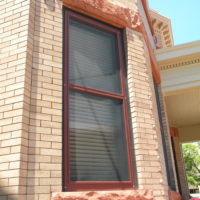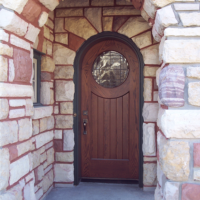STORM WINDOW FAQs (FREQUENTLY ASKED QUESTIONS)
Category: Measuring
Do you downsize from the measurements I give you?
No. We fabricate all of our storms full and square to the measurements that we are provided. We work in width x height for all of our measurements.
If you need assistance in measuring your storm windows, check out our instructions: How to Measure a Storm Window
How do I measure the sill angle?
There are several methods that you can use:
- The easiest is to use a digital angle finder. You can either purchase this from a hardware store or an iPhone has a measure tool that includes a digital angle measure.
- Measure the distance from the back of where the storm would be placed in the window and measure the distance from the front of where the storm would be placed in the window (1-1/8″ apart). The difference between measurements will provide your sill angle.
- 1/8″ = 4 degree sill angle
- 1/4″ = 7 degree sill angle
- 3/8″ = 11 degree sill angle
- 1/2″ = 14 degree sill angle
- Using a protractor and carpenters square, measure the angle created by the sill.
How do I measure for the center bar location?
Always measure from the top of the opening to the middle of where your top and bottom sash meet. If you measure from the bottom up, due to the sill angle, it might not end up being the correct location.
If you ask for the center bar centered, there are two different ways to treat that.
- It can be centered on the height. For example, on a 32” x 56” window, the center bar would be placed at 28” from the top of the storm windows.
- It can be centered on the glass opening. This is different because the top rail is 2-1/8” and the bottom rail is 3-1/2”. Using the same example for a 32” x 56” window, the center bar would be placed at 27-5/16”.
Unfortunately, if you give us bottom-up height, you will have to re-measure as we cannot use this dimension. Accuracy requires a top-down measurement.
Do I need to add weep holes to my storm window? OR Can I add insulation/caulk around my storm windows?
You need to either add weep holes or leave space in order for condensation to escape. If moisture builds up between your window sash and your storm/screen window, it will rot your window sash bottom rail, window sill, and storm window bottom rail. Studies have shown that the weep hole (or space left at the bottom of a storm window) is negligible to the decrease in efficiency of adding a storm window.
Option 1: Weep holes. These are added by drilling 1/4″ holes at the base of the storm window (matching the sill angle). Usually, these are added on both sides of the bottom rail.
Option 2: Space. Place one or two pennies on each side of the storm window. You need to take a deduction in height from the full height to allow this space. Instead of using pennies, you can glue small pieces of wood to the bottom to create the same effect.
Can I get a storm window with a vertical center bar?
Yes! If you need a vertical center bar, we can fabricate a storm window like that. It needs to be specified in our estimate that it is a vertical center bar as our standard is a horizontal center bar.
What if I don’t have a meeting rail and don’t want a center bar?
We can fabricate your storm windows without a center bar. If this is a picture window and you don’t want to disrupt your view, we can work to ensure the storm window will not need a center bar. Depending on the size of the storm window, we might need to use thicker glass to support the size. Your storm window specialist will include that information on your estimate.
We may have to construct the storm window differently by using wood stop in lieu of putty to hold thicker, heavier glass in place. This will be noted on your estimate.
What if I don’t want a wider bottom rail?
We can fabricate with specific part sizes at an additional cost for setup. If you have a basement window that has the same width frame on all four sides, we can fabricate a storm with the same part sizes for all stiles and rails.
What if I have a rounded (special or custom) shape on the top of my window?
We can fabricate your storm windows with a half round or arched top to match your window. We have instructions available to figure out the angle available here: Measuring Arched Top. To provide us the information needed for this type of storm window, here is the Arched Storm Window Measurement Form.
Gothic top or pentoid are other shapes that we have constructed in the past. Drawings or photos are always helpful if you have a very custom window.
We also recommend providing us with a template that we can match. It can either be made out of cardboard, OSB (or something similar), or thick paper. Feel free to talk to us about it in more detail!
My windows don’t have enough space for storms that are 1-1/8” thick. What do I do?
Our storm windows are designed to sit flush with your trim, against the window casing (see How to Measure) We have two different options available for this situation. The first option would be our recommendation and preference, but both can be done.
- We can rabbet the back of the storm to meet your spacing requirements. The form that we use to ensure we have all of the necessary information is: Adams Rabbeting Information
- We can fabricate down to ¾” thick to match the allowable thickness of your windows. This can, however, affect the structural stability of the storm windows, especially if they are large.
If you have special circumstances with your windows, contact us at 1-888-285-8120.
Do you have representatives in our city or state?
Unfortunately, no. We fabricate storm windows and ship them across the United States. We do not have the staff to measure for your storm windows but we are always happy to help you measure correctly! Give us a call at 888-285-8120 to talk through measuring or send photos to get assistance. Our favorite measuring instructions are color-coded and describe each part of the window so that you understand exactly where to measure. They can be found here: How to Measure–Including Photos
Category: Painting / Finishing
Do I need to allow room at the bottom of the storm to create weep holes?
Yes, you can either make weep holes (by drilling a 1/4″ hole in two or more places on the bottom rail) or leave 1/16″ to 1/8″ space at the bottom of the storm window. This allows condensation to wick away from your window sash, the storm bottom rail, and your sill to reduce the likelihood of those rotting. Condensation will naturally occur due to temperature changes between the exterior and interior temperatures. If you seal the storm window completely, there is no escape for the condensation and that water will sit between your sash and storm window on the sill, causing the wood to rot.
A practice that has been handed down over the years is to glue or affix pennies to the bottom of the storm to keep it from sitting on the sill and possibly absorbing moisture. If the storm window sits directly on the sill, it can cause deterioration over time.
Can I use weatherstrip to seal my storm windows?
That is not something that we recommend due to condensation issues (see information on weep holes above). If you do want to add weatherstrip, we do not allow space for it and you would need to compensate/deduct for that in the dimensions that you provide to us. We fabricate to the exact measurements provided.
Do I paint the putty glaze?
Yes! (But the first step is to prime, of course!) The best way to protect the putty glaze elasticity is to paint over the putty onto the glass to seal the putty glaze. It does not need to cover much of the glass (1/16” to 1/8”), but that will seal the putty glaze to protect it from the elements. We recommend that you prime over the putty as well., helping to lock in the moisture.
What paint or primer do I use?
We provide a factory primer using Sherwin Williams Exterior Latex Primer in white. If you are painting your storm windows a dark color, we suggest that you request grey primer (it is a small additional cost) as the tinting will assist with the coverage of your darker paint of choice.
If you use latex primer, use latex paint over it. If you use oil-based primer, you can either use latex paint or oil-based paint. Make sure it is an exterior primer and paint that you purchase as they have better weather-resistant properties than interior paint products.
Category: Installation
How do I put together a Ready-to-Assemble (RTA) Traditional Storm Window Kit?
Our instructions can be found here: Assembly Instructions for Adams RTA Kit
How do I figure my glass sizes for a Ready-to-Assemble (RTA) Kit?
If you are ordering glass for your RTA Kit, we have instructions on how we recommend you size it: How to Figure Glass Sizes for RTA Kits
How do I hang my storm windows?
The most historically accurate method is to use sash hangers (which you can purchase online or from us) that have a hook & loop to the inside to hold the bottom of the storm window in place. You can also use turn buttons that attach to the exterior and . The last method (and probably the least recommended) is to screw them into place. The reason you don’t want to permanently adhere your storms into the window is that you will want to be able to update paint and clean glass as needed.
If you need some additional information on hanging your storm windows, check out our installation instructions: How to Install Wood Storm Windows
Category: Maintenance
Do I need to take my storm windows down every year?
It is best to take down your storm windows each year to inspect them and re-paint or repair as needed. It will also give you a chance to clean the glass as well. Making sure the paint is not chipped or peeling will ensure that the wood is protected to ensure longevity of your storm windows.
What do I do if my putty glaze is cracking?
At this point, you would need to replace the putty glaze on your storm windows. We recommend Sarco Type M putty glaze. It can be purchased from these distributors: https://www.sarcoputty.com/where-to-buy.
How do I putty glaze my storm window?
Here is a video that provides the basics of putty glazing: https://www.sarcoputty.com/helpful-videos
The tools required to putty glaze is a putty knife (we prefer a stiff bent blade) and latex gloves (this will help protect your skin from drying out). Using fresh putty will make this task easier. (You can add linseed oil to freshen up older putty.)
Also, you want to clean the glass right away after glazing as it will be easier to clean up and help to reduce curing time.
How can I clean my self-storing storm?
If you want to remove the panels from your Self-Storing Storm Window to clean or repair a pane, the instructions are here: Remove Panels in Self-Storing Storm Window
Category: Miscellaneous
When do I use insulated glass?
We recommend insulated glass for areas that experience lots of noise and/or activity as well as places that get lots of wind and/or weather.
Some additional information in regard to insulated glass and the benefits can be found at this link: Storm Windows with Insulated Glass
Why don’t the rails extend the full length of the storm window?
We intentionally make the rails slightly shorter to get a tight fit during clamping/assembly. When the clamp locks the stile and rails together, it does not bottom out on the rail. If the rail was the same width as the overall storm width, the clamp may hit the rail first and the part may not clamp tight and the joint could be loose or show a gap. The shorter rails prevent the clamp from bottoming out.
What is the difference between putty glaze and wood stop?
Both putty glaze and wood stop are used to hold the glass in place on a storm window. Putty glaze is applied to the exterior of the storm window after the glass has been pinned in place with diamond points. Wood stop is used to the interior of a storm window to hold in the glass. With wood stop, there is a bed of caulk that is used in conjunction with the wood stop to avoid water seepage.
Diagram of putty glaze and wood stop on a storm window: Putty Glaze vs. Wood Stop
Can I get a vertical center bar on a self-storing storm?
No, due to the construction of a Self-Storing Storm, it is not possible for it to work with a vertical center bar. You could, however, use any of our combination storm and screen storm windows with a vertical center bar.
What do I do if I want divided lite bars in my storm to match my window?
We can fabricate a storm window with divided lites instead of, or in addition to, a center bar. We need to know how many openings (panes of glass) are being requested. The way that we describe them is the number of openings across the width by the number of openings on the height (#W#H). For example, if there are 6 panes of glass, it could either be 3W2H (3 openings on the width and 2 openings on the height) or 2W3H (2 openings on the width and 3 openings on the height). There are additional costs associated with adding divided lite bars to a storm window.












